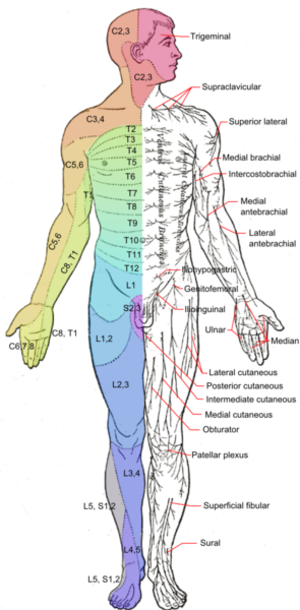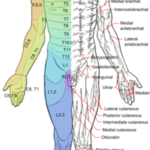The nervous system is responsible for the transmission of chemical and electrical signals throughout the body. Nerve cells within the nervous system are referred to as neurons and are what allows the nervous system to communicate with the cells of the body.
All neurons within the nervous system must demonstrate three important qualities. Each neuron must be capable of responding to stimuli. This response to stimuli is often known as excitability. Neurons must also be conductive, capable of responding to stimuli and passing messages to other neurons and cells. Neurons must also be capable of secreting chemicals (often known as neurotransmitters) that pass through the space between cells, allowing messages to be transferred and receiving cells to be stimulated.
The Structure of a Neuron
There are many different types of neurons, but most neurons are structured in one general way, with slight variations. A nucleus is located within the cell body of the neuron with dendrites and axons extended from the cell body. The central part of the neuron is known as the soma, and acts as the control center for the neuron. The soma is sometimes referred to as the neurosoma or perikaryon. The soma contains a nucleus and a large nuclear envelope, or nucleolus. The cytoplasm within the neuron contains many of the same organelles found within other cells, such as mitochondria, the golgi complex and the endoplasmic reticulum. The cytoplasm of a neuron contains microtubules composed of neurofibrils. These neurofibrils can be found within the endoplasmic reticulum and areas known as Nissl bodies.
On one side of the soma, a small rounded structure known as the axon hillcock is present. From this structure, the axon, or the nerve fiber, extends. The cytoplasm of the axon is referred to as the axoplasm, while the membrane is referred to as the axolemma. A neuron cannot have more than a single axon. On one end of the axon, a series of thin branches known as the terminal arborization are present. At the end of each of these branches is a synaptic knob that forms a junction with a nearby cell, known as a synapse. Within the knob, synaptic vessels are present and are responsible for the release of neurotransmitters.
Processes known as dendrites extend from within the soma. Dendrites are the fibers that branch off of the axon and serve as the primary reception site of signals transmitted from other neurons. Some neurons may only contain a couple dendrites, while some neurons may contain hundreds or even thousands of dendrites.
Variations in the Structure of Neurons
As stated previously, some neurons variate in structure.
Multipolar Neurons
Multipolar neutrons contain a single axon and numerous dendrites.
Bipolar Neurons
Bipolar neurons contain a single axon and a single dendrite.
Unipolar Neurons
Unipolar neurons contain a single process extending from the soma.
Anaxonic Neurons
Anaxonic neurons contain numerous dendrites but do not possess an axon.
Classes of Neurons
Neurons are divided into three classes; sensory neurons, interneurons and motor neurons.
Sensory Neurons
Sensory neurons are responsible for maintaining the senses of touch, semll, taste, sound and sight. These neurons are responsible for connecting the components of these senses to the central nervous system. Sensory neurons are sometimes referred to as afferent neurons.
Interneurons
Interneurons are located within the central nervous system and are responsible for recieving chemical and electrical signals from many different types of neurons. These neurons are responsible for determining reactions to stimuli. The interneurons are sometimes referred to as association neurons.
Motor Neurons
Motor neurons are primarily responsible for the passage of signals to the muscles and glands within the body. Motor neurons are sometimes referred to as efferent neurons.
Axonal Transport
Organelles, proteins and other substances are capable of being transported up and down the axon, toward and away from the soma by means of axonal transport. Transport towards the some, up the axon is known as
retrograde transport while transport down the axon, away from the soma is known as anterograde transport. Axonal transport is divided into two categories; fast axonal transport and slow axonal transport.
Fast Axonal Transport
Fast axonal transport can be anterograde or retrograde. Fast anterograde transport occurs when organelles such as mitochondria, or other substances, such as calcium ions, enzymes and other molecules are moved away from the soma. Fast retrograde transport is similar, however, substances are being moved toward the soma. The nervous system can be penetrated by foreign pathogens through fast retrograde transport.
Slow Axonal Transport
Slow axonal transport is always anterograde, and occurs much more slowly than fast axonal transport. Slow axonal transport is responsible for the renewal of axoplasm within exhausted neurons. The speed of the repair of injured nerve fibers is directly related to the speed of slow axonal transport.
References
Saladin, Kenneth S.. Anatomy & physiology: the unity of form and function. 5th ed. Dubuque: McGraw-Hill, 2010. Print.
Slow Axonal Transport: Basic Neurochemistry
Neurons
Types of Neurons
Human Physiology: Neurons & the Nervous System
Cells of the Nervous System
Neurons






